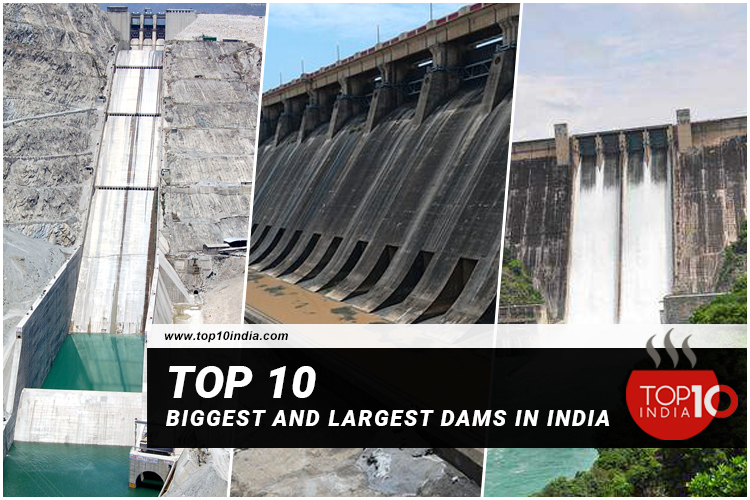Top 10 Biggest and Largest Dams in India: Tehri Dam is the Number 1 biggest and largest dam in India and the highest dam in India and counted among the highest across the world.
Top 10 Biggest and Largest Dams in India
India is a country that holds several largest and deepest rivers like Ganga, Brahmaputra, and Narmada in its heart. We all know the importance of water for human beings or living things, so storing water is essential. This is why Govt. of India is looking forward to the construction of new dams in India. The key intentions behind constructing dams are avoiding flooding, providing power, and delivering water whenever needed. So, have a look at the top 10 biggest and largest dams in India.
No 1. Tehri Dam
Tehri Dam is the biggest and largest dam in India and the highest dam in India and counted among the highest across the world. The Tehri Dam is the tallest in India. It is a multi-purpose rock and earth-fill embankment dam on the Bhagirathi River near Tehri in Uttarakhand, India. It is the primary dam of the THDC India Ltd. and the Tehri hydroelectric complex. Phase 1 was completed in 2006. The Tehri Dam withholds a reservoir for irrigation, municipal water supply, and the generation of 1,000 megawatts (1,300,000 hp) of hydroelectricity. The dam’s 1,000 MW variable-speed pumped-storage scheme is currently under construction with expected commissioning in May 2018.
| Current Status | It is operational |
| Date of Opening | 2006 |
| Owner | THDC INDIA LIMITED |
| Height of the dam | 260.5 m (855 ft) |
| Length of the dam | 575 m (1,886 ft) |
| Total capacity | 4.0 km3 (3,200,000 acre⋅ft) |
No 2. Hirakund Dam
Hirakud Dam is built across the Mahanadi River, about 15 kilometers (9 mi) from Sambalpur in the state of Odisha in India. Behind the dam extends a lake, Hirakud Reservoir, 55 km (34 mi) long. It is one of the first major multipurpose river valley projects started after India’s independence. It is one of the biggest and largest dams in India. In 1952, Mazumdar Committee was appointed by the government to oversee the soundness and technical feasibility of the project. The committee has envisaged costs of ₹ 92.80 crores for the project and that the construction of the main dam would be complete by June 1955. It also said that by 1954–55 a total of 1,347,000 acres (545,000 ha) would be irrigated and that 48,000 kW of electric power would be generated.
| Current Status | It is operational |
| Date of Opening | 1957 |
| Height of the dam | 60.96 m (200 ft) |
| Length of the dam | 4.8 km (3 mi) (main section)
25.8 km (16 mi) (entire dam) |
| Total capacity | 5,896,000,000 m3 (4,779,965 acre⋅ft) |
No 3. Bhakra Dam
Bhakra Dam is a concrete gravity dam on the Sutlej River in Bilaspur, Himachal Pradesh, in northern India. The dam forms the Govind Sagar reservoir. The dam, located at a gorge near the (now submerged) upstream Bhakra village in Bilaspur district of Himachal Pradesh of height 226 m. The length of the dam (measured from the road above it) is 518.25 m, and the width is 9.1 m. Its reservoir is known as “Gobind Sagar,” which stores up to 9.34 billion cubic meters of water.
| Current Status | It is operational |
| Date of Opening | 1963 |
| Height of the dam | 741 ft (226 m) |
| Length of the dam | 1,700 ft (520 m) |
| Total capacity | 9.340 km3 |
No 4. Nagarjuna Sagar Dam
Nagarjuna Sagar Dam is a masonry dam across the Krishna River at Nagarjuna Sagar, straddling the border between Guntur district in Andhra Pradesh and Nalgonda district in Telangana. It is constructed between 1955 and 1967; the dam created a water reservoir with a gross storage capacity of 11.472 billion cubic meters (405.1×109 cu ft). Andhra Pradesh and Telangana jointly operate it. Nagarjuna Sagar Dam was the earliest in a series of large infrastructure projects termed “modern temples” initiated to achieve the Green Revolution in India. It is also one of the earliest multi-purpose irrigation and hydroelectric projects in India. The dam provides irrigation water to the Nalgonda, Suryapet, Krishna, Khammam, West Godavari, Guntur, Prakasam districts and electricity generation.
| Current Status | It is operational |
| Date of Opening | 1967 |
| Height of the dam | 124 meters (407 ft) |
| Length of the dam | 1,550 meters |
| Total capacity | 11.56×109 m3 (9×106 acre⋅ft)
(405 Tmcft) |
No 5. Cheruthoni Dam
The Cheruthoni Dam, located in Idukki District, Kerala, India, is a 138m tall concrete gravity dam. This dam was constructed as part of the Idukki Hydroelectric Project and two other dams at Idukki and Kulamavu. The project was completed with Canadian aid. The Government of Canada aided the Project with long-term loans and grants. S.N.C.Inc., Canada, a consulting engineer firm, was advising and assisting Project Engineers under the Canadian Aid.
| Current Status | It is operational |
| Date of Opening | 1976 |
| Owner | Kerala State Electricity Board |
| Height of the dam | 138.2 m (453 ft) |
| Length of the dam | 650.9 m (2,135 ft) |
| Total capacity | 1,996,000,000 m3 (1,618,184 acre⋅ft) |
| Active capacity | 1,459,000,000 m3 (1,182,831 acre⋅ft) |
No 6. Krishna Raja Sagar Dam
Krishna Raja Sagara, also popularly known as KRS, is a lake and the dam that creates it. They are close to the settlement of Krishna raja Sagara in the Indian State of Karnataka. The gravity dam made of suki mortar is below the confluence of river Kaveri with its tributaries Hemavati and Lakshmana Tirtha in the district of Mandya. Krishna Raja Wadiyar IV Maharaj of Mysore constructed the dam during famine despite the critical financial condition in State. One of the architects of the dam was Chief Engineer of Mysore M. Visvesvaraya. There is an ornamental garden, Brindavan Gardens, attached to the dam.
| Current Status | It is operational |
| Date of Opening | 1911 |
| Operator | Cauvery Neeravari Nigam Limited |
| Height of the dam | 39.8 m (131 ft) |
| Length of the dam | 2,620 m (8,600 ft) |
| Total capacity | 1,368,847,000 m3 (1,109,742 acre⋅ft) |
| Active capacity | 124,421,000 m3 (100,870 acre⋅ft) |
No 7. Mettur Dam (Top 10 Biggest and Largest Dams in India )
The Mettur Dam is one of India’s largest dams and the largest in Tamil Nadu, located across the river Cauvery where it enters the plains. Built in 1934, it took 9 years to complete. The maximum height and width of the dam are 214 and 171 feet, respectively. The dam receives inflows from its own catchment area, Kabini Dam and Krishna Raja Sagara Dams, located in Karnataka. There is a park at the base of the dam called Ellis Park, maintained by the Tamil Nadu Public Works Department. It provides irrigation and drinking water facilities for more than 12 districts of Tamilnadu and hence is revered as the life and livelihood-giving asset of Tamil Nadu.
| Current Status | It is operational |
| Date of Opening | 1934 |
| Height of the dam | 120 feet (37 m) |
| Length of the dam | 1,700 metres (5,600 ft) |
| Total capacity | 1 93.4 billion ft³ (2.64 km³) 2,146,071 acre-ft |
No 8. Bisalpur Dam (Top 10 Biggest and Largest Dams in India )
Bisalpur Dam is a gravity dam on the Banas River near Dara Singh in Tonk district, Rajasthan, India. The dam was completed in 1999 for irrigation and water supply. The Bisalpur dam was constructed in the 1990s by the Rajasthan state government. During the construction, the people displaced by the dam protested against the state government’s rehabilitation and resettlement policy, calling it unjust. In October 1999, the Ashok Gehlot-led Congress government sanctioned a project to bring the Bisalpur reservoir water to the state capital Jaipur. However, the project could not be implemented because of financial constraints. In 2004, the Vasundhara Raje-led BJP government started constructing a pipeline to bring Bisalpur water to Jaipur.
| Current Status | It is operational |
| Date of Opening | 1999 |
| Height of the dam | 39.5 m (130 ft) |
| Length of the dam | 574 m (1,883 ft) |
| Total capacity | 1 93.4 billion ft³ (2.64 km³) 2,146,071 acre-ft |
| Active capacity | 1,040,000,000 m3 (843,142 acre⋅ft) |
No 9. Koyna Dam (Top 10 Biggest and Largest Dams in India )
The Koyna Dam is one of the largest dams in Maharashtra, India. It is a rubble-concrete dam constructed on the Koyna River, which rises in Mahabaleshwar, a hill station in the Sahyadri ranges. It is located in Koyna Nagar, Satara district, nestled in the Western Ghats on the state highway between Chiplun and Karad.
| Current Status | It is operational |
| Owner | Government of Maharashtra |
| Date of Opening | 1964 |
| Height of the dam | 103.2 m (339 ft) |
| Length of the dam | 807.2 m (2,648 ft) |
| Total capacity | 2,797,400,000 m3 (2,267,900 acre⋅ft) |
| Surface area | 891.78 km2 (344 sq mi) |
No 10. Maithon Dam (Top 10 Biggest and Largest Dams in India )
The Maithon Dam is located at Maithon, 48 km from Dhanbad, in Jharkhand, India. It is 15,712 ft (4,789 m) long and 165 ft (50 m) high. This dam was specially designed for flood control and generated 60,000 kW of electric power. There is an underground power station, the first of its kind in the whole of southeast Asia. The dam is constructed on the Barakar River. The lake is spread over 65 square kilometers (25 sq mi).
| Current Status | It is operational |
| Owner | Damodar Valley Corporation |
| Date of Opening | 1957 |
| Height of the dam | 165 ft (50 m) |
| Length of the dam | 15,712 ft (4,789 m) |
| Width (base) | 10.67 meters (35.0 ft) |
| Surface area | 65 square kilometers (25 sq mi) |
FAQ
1. Which is the No. 1 Largest and Biggest Dam in India?
Tehri Dam is the No. 1 Largest and Biggest Dam in India.
2. Which is the biggest dam in India?
Tehri Dam is the biggest dam in India.
3. Which is the first dam in India?
Kallanai Dam is the first dam in India.
4. Which is the largest dam in Asia?
Banasura Sagar Dam is the largest dam in Asia.
5. Which is the highest dam in the world?
Nurek Dam is the highest dam in the world.













Be First to Comment